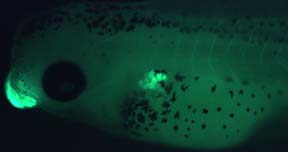Alpha-tubulin - microtubules and ECL - pronephric nephrons: Difference between pages
(Difference between pages)
No edit summary |
(Created page with "'''Erythrina Cristagalli Lectin (ECL)''' Vector labs FL-1141 (fluorescein conjugated). [[Image:ECL_1.jpg|thumb|alt=ALT TEXT|Xenopus laevis embryo stained with fluorescein conj...") |
||
| Line 1: | Line 1: | ||
''' | '''Erythrina Cristagalli Lectin (ECL)''' | ||
Vector labs FL-1141 (fluorescein conjugated). | |||
[[Image:ECL_1.jpg|thumb|alt=ALT TEXT|Xenopus laevis embryo stained with fluorescein conjugated ECL (Image from P. Vize [http://www.xenbase.org/community/person.do?method=display&personId=702&tabId=0])]] | |||
Stains the proximal pronephric tubules and cement gland. Somite borders also weakly stained. Can be used as a counterstain on embryos already processed via in situ hybridization. | |||
Latest revision as of 10:50, 4 February 2011
Erythrina Cristagalli Lectin (ECL)
Vector labs FL-1141 (fluorescein conjugated).

Stains the proximal pronephric tubules and cement gland. Somite borders also weakly stained. Can be used as a counterstain on embryos already processed via in situ hybridization.